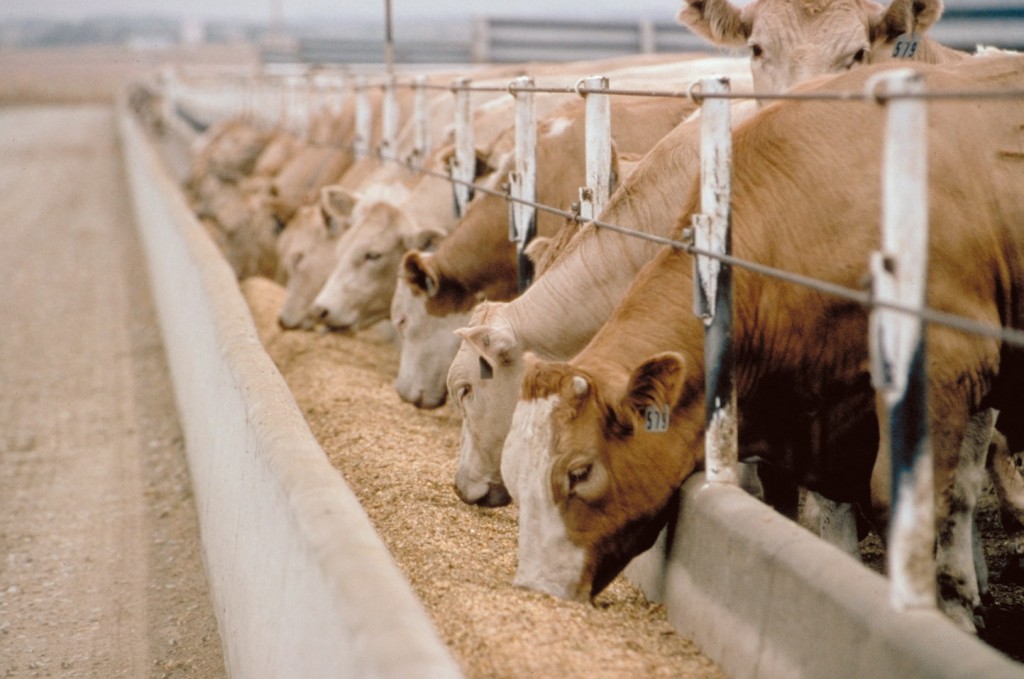
Grain-Fed Cattle
Courtesy of Institute for Livestock & the Environment
The industrial livestock sector is heating our planet at an alarming pace and will continue to do so unless sweeping changes are made to production practices and consumer habits. The contemporary conversation around climate change tends to focus on the consequences of an overreliance on fossil fuels. Meat production is often overlooked as a significant contributor to the climate crisis, despite emitting 18 percent of global greenhouse gases – a percentage point larger than that of all modes of transportation. Considering the ramifications of climate change, it is crucial to analyze and transform the relationship between meat production and the environment.
Technological innovation and advances in production from the latter half of the nineteenth century to the mid-twentieth century spurred the rise of the industrial livestock sector in the United States. Whereas previous methods of meat production were small scale and allowed animals to roam in fields, the industrial livestock sector placed an increased emphasis on maximizing profit and yields. This resulted in the introduction of confined animal feeding operations (CAFOs).
In the 1920s, industrial animal farms expanded significantly with the discovery that the addition of vitamins A and D to animal feed allowed farmers to confine animals indoors all year round. This accelerated the processes of production and proved to be crucial in the development of the slaughterhouse we know today. When the overcrowded quarters led to the spread of disease, the industry responded with antibiotics. While antibiotics reduced mortality rates among livestock, it also enhanced growth and weight gain. Technological advancements, government subsidies, and the introduction of drugs among other factors prompted a shift away from traditional small-scale farming towards agribusiness. The industrial livestock sector brought about dynamic changes to the production and affordability of meat, leaving small-scale farms unable to compete.
In terms of profitability and scale, today’s meat industry has reached its zenith, with experts projecting that significant future growth is still in store. Over the past few decades, meat supply and consumption per capita have paralleled in growth in many regions of the world. The United Nations Environment Programme (UNEP) suggests these increases are strongly tied to rising levels of income and population growth. Specifically from 1960 to 2010, the global population doubled hitting six billion, while the total amount of meat produced annually sky rocketed from 70 million tons to 278 million tons. Further, the Food and Agriculture Organization of the United Nations (FAO) predicts global meat consumption to reach 460 million tons by 2050 if current trends continue.
Environmentally, raising livestock in CAFOs is an energy intensive process reliant on huge amounts of water, fuel, fertilizer, and feed. For example, NPR News correspondents Allison Aubrey and Dan Charles contend that the production of a single quarter-pound hamburger requires 6.7 pounds of grain for feed, 52.8 gallons of water, 74.5 square feet of land for grazing and feed crop production, and 1,036 Btus of fossil fuel energy. Considering that 56 billion livestock are raised and killed annually world wide, such excessive inputs become problematic.
The meat industry is responsible for nine percent of global anthropogenic carbon dioxide emissions and is associated with roughly 37 percent of methane emissions and 65 percent of nitrous oxide emissions. While all three gases contribute to climate change, methane and nitrous oxide have global warming potentials 23 and 296 times more potent than that of carbon dioxide.
Emissions can be traced all along the meat production process. For instance, methane is excreted primarily as a byproduct from the wind and tailpipes of cattle through enteric fermentation, a digestive process in which carbohydrates are broken down. The use of synthetic fertilizer on feed crop plantations releases nitrous oxide through processes of nitrification and denitrification. And, carbon dioxide is expelled in considerable amounts through transportation and deforestation by the meat industry. Such emissions, and a host of other environmental concerns created by meat production, exist as externalities of industry. Critics argue that U.S government policies favor industrial livestock, and thus exempt CAFOs from limiting environmental impacts and rectifying the negative implications of their operations.
Today, livestock is a major source of income, revenue, and protein despite harmful externalities. Over the next several weeks this blog will explore the impact of the industrial livestock sector on climate change. Topics for discussion include the history of livestock production, regulation and public policy of the meat industry, and environmental complications. The solutions are not simple, however understanding environmental consequences of the industrial livestock sector opens up the possibility for positive change in the future.